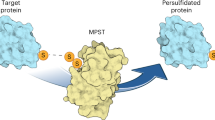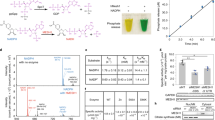Abstract
Reactive oxygen species trigger cellular responses by activation of stress-responsive mitogen-activated protein kinase (MAPK) signalling pathways1,2. Reversal of MAPK activation requires the transcriptional induction of specialized cysteine-based phosphatases that mediate MAPK dephosphorylation3. Paradoxically, oxidative stresses generally inactivate cysteine-based phosphatases by thiol modification and thus could lead to sustained or uncontrolled MAPK activation4,5. Here we describe how the stress-inducible MAPK phosphatase, Sdp1, presents an unusual solution to this apparent paradox by acquiring enhanced catalytic activity under oxidative conditions. Structural and biochemical evidence reveals that Sdp1 employs an intramolecular disulphide bridge and an invariant histidine side chain to selectively recognize a tyrosine-phosphorylated MAPK substrate. Optimal activity critically requires the disulphide bridge, and thus, to the best of our knowledge, Sdp1 is the first example of a cysteine-dependent phosphatase that couples oxidative stress with substrate recognition. We show that Sdp1, and its paralogue Msg5, have similar properties and belong to a new group of phosphatases unique to yeast and fungal taxa.
This is a preview of subscription content, access via your institution
Access options
Subscribe to this journal
Receive 51 print issues and online access
$199.00 per year
only $3.90 per issue
Buy this article
- Purchase on Springer Link
- Instant access to full article PDF
Prices may be subject to local taxes which are calculated during checkout




Similar content being viewed by others
References
Ikner, A. & Shiozaki, K. Yeast signaling pathways in the oxidative stress response. Mutat. Res. 569, 13–27 (2005)
Chang, L. & Karin, M. Mammalian MAP kinase signalling cascades. Nature 410, 37–40 (2001)
Keyse, S. M. Protein phosphatases and the regulation of mitogen-activated protein kinase signalling. Curr. Opin. Cell Biol. 12, 186–192 (2000)
Tonks, N. K. Redox redux: revisiting PTPs and the control of cell signaling. Cell 121, 667–670 (2005)
Salmeen, A. & Barford, D. Functions and mechanisms of redox regulation of cysteine-based phosphatases. Antioxid. Redox Signal. 7, 560–577 (2005)
Barford, D., Das, A. K. & Egloff, M. P. The structure and mechanism of protein phosphatases: insights into catalysis and regulation. Annu. Rev. Biophys. Biomol. Struct. 27, 133–164 (1998)
Alonso, A. et al. Protein tyrosine phosphatases in the human genome. Cell 117, 699–711 (2004)
Pulido, R., Zuniga, A. & Ullrich, A. PTP-SL and STEP protein tyrosine phosphatases regulate the activation of the extracellular signal-regulated kinases ERK1 and ERK2 by association through a kinase interaction motif. EMBO J. 17, 7337–7350 (1998)
Mattison, C. P., Spencer, S. S., Kresge, K. A., Lee, J. & Ota, I. M. Differential regulation of the cell wall integrity mitogen-activated protein kinase pathway in budding yeast by the protein tyrosine phosphatases Ptp2 and Ptp3. Mol. Cell. Biol. 19, 7651–7660 (1999)
Rhee, S. G., Bae, Y. S., Lee, S. R. & Kwon, J. Hydrogen peroxide: a key messenger that modulates protein phosphorylation through cysteine oxidation. Sci. STKE 1 doi: 10.1126/stke.2000.53.pe1 (2000)
Salmeen, A. et al. Redox regulation of protein tyrosine phosphatase 1B involves a sulphenyl-amide intermediate. Nature 423, 769–773 (2003)
Seth, D. & Rudolph, J. Redox regulation of MAP kinase phosphatase 3. Biochemistry. 45,–8476–8487 (2006)
Martin, H., Flandez, M., Nombela, C. & Molina, M. Protein phosphatases in MAPK signalling: we keep learning from yeast. Mol. Microbiol. 58, 6–16 (2005)
Staleva, L., Hall, A. & Orlow, S. J. Oxidative stress activates FUS1 and RLM1 transcription in the yeast Saccharomyces cerevisiae in an oxidant-dependent manner. Mol. Biol. Cell 15, 5574–5582 (2004)
Alic, N., Higgins, V. J., Pichova, A., Breitenbach, M. & Dawes, I. W. Lipid hydroperoxides activate the mitogen-activated protein kinase Mpk1p in Saccharomyces cerevisiae. J. Biol. Chem. 278, 41849–41855 (2003)
Vilella, F., Herrero, E., Torres, J. & de la Torre-Ruiz, M. A. Pkc1 and the upstream elements of the cell integrity pathway in Saccharomyces cerevisiae, Rom2 and Mtl1, are required for cellular responses to oxidative stress. J. Biol. Chem. 280, 9149–9159 (2005)
Krasley, E., Cooper, K. F., Mallory, M. J., Dunbrack, R. & Strich, R. Regulation of the oxidative stress response through Slt2p-dependent destruction of cyclin C in Saccharomyces cerevisiae. Genetics 172, 1477–1486 (2006)
Levin, D. E. Cell wall integrity signaling in Saccharomyces cerevisiae. Microbiol. Mol. Biol. Rev. 69, 262–291 (2005)
Hahn, J. S. & Thiele, D. J. Regulation of the Saccharomyces cerevisiae Slt2 kinase pathway by the stress-inducible Sdp1 dual specificity phosphatase. J. Biol. Chem. 277, 21278–21284 (2002)
Collister, M. et al. YIL113w encodes a functional dual-specificity protein phosphatase which specifically interacts with and inactivates the Slt2/Mpk1p MAP kinase in S. cerevisiae. FEBS Lett. 527, 186–192 (2002)
Groom, L. A., Sneddon, A. A., Alessi, D. R., Dowd, S. & Keyse, S. M. Differential regulation of the MAP, SAP and RK/p38 kinases by Pyst1, a novel cytosolic dual-specificity phosphatase. EMBO J. 15, 3621–3632 (1996)
Todd, J. L., Tanner, K. G. & Denu, J. M. Extracellular regulated kinases (ERK) 1 and ERK2 are authentic substrates for the dual-specificity protein-tyrosine phosphatase VHR. A novel role in down-regulating the ERK pathway. J. Biol. Chem. 274, 13271–13280 (1999)
Delauney, A., Pflieger, D., Barrault, M. B., Vinh, J. & Toledano, M. B. A thiol peroxidase is an H2O2 receptor and redox-transducer in gene activation. Cell 111, 471–481 (2002)
Jia, Z., Barford, D., Flint, A. J. & Tonks, N. K. Structural basis for phosphotyrosine peptide recognition by protein tyrosine phosphatase 1B. Science 268, 1754–1758 (1995)
Stewart, A. E., Dowd, S., Keyse, S. M. & McDonald, N. Q. Crystal structure of the MAPK phosphatase Pyst1 catalytic domain and implications for regulated activation. Nature Struct. Biol. 6, 174–181 (1999)
Kellis, M., Birren, B. W. & Lander, E. S. Proof and evolutionary analysis of ancient genome duplication in the yeast Saccharomyces cerevisiae. Nature 428, 617–624 (2004)
Flandez, M., Cosano, I. C., Nombela, C., Martin, H. & Molina, M. Reciprocal regulation between Slt2 MAPK and isoforms of Msg5 dual-specificity protein phosphatase modulates the yeast cell integrity pathway. J. Biol. Chem. 279, 11027–11034 (2004)
Kamata, H. et al. Reactive oxygen species promote TNFα-induced death and sustained JNK activation by inhibiting MAP kinase phosphatases. Cell 120, 649–661 (2005)
Barford, D. The role of cysteine residues as redox-sensitive regulatory switches. Curr. Opin. Struct. Biol. 14, 679–686 (2004)
Veal, E. A. et al. A 2-Cys peroxiredoxin regulates peroxide-induced oxidation and activation of a stress-activated MAP kinase. Mol. Cell 15, 129–139 (2004)
Acknowledgements
G.C.F. was supported by a studentship from GlaxoSmithKline. N.Q.M. and S.M.K. are funded by CR-UK. M.J.R.S. is supported by BBSRC. We thank M. Toledano for experimental advice, T. Kuno for the Pmp1 plasmid and M. Way for critical comments on the manuscript. We also thank M. Cobb for the gift of the ERKpTpY expression vector, D. Thiele and J.-S. Hahn for yeast strains and Sdp1 expression plasmids, and A. Stewart, S. Tilley and J. Denu for assistance with early experiments.
Author Contributions G.C.F. and N.Q.M. determined the apo and sulphate-bound structures. M.S. determined the phosphotyrosine structure and carried out pNPP and ERK2 assays and blots. D.C.B. and N.Q.M. refined the structures. P.P.K. measured the free -SH content and reproduced all kinetic experiments. S.M.K. and M.J.R.S. designed the in vivo assays. M.C, M.J.D, V.M., and R.J.D. carried out in vivo assays using Myc-tagged Sdp1 proteins. S.H. and N.T carried out the mass spectrometry. S.M.K. and N.Q.M planned the project and designed the experiments. N.Q.M., S.M.K. and D.C.B. wrote the paper.
Coordinates have been deposited at the PDB with accession codes 2j16 (apo/sulphate-bound Sdp1) and 2j17 (phosphotyrosine–Sdp1 complex)
Author information
Authors and Affiliations
Corresponding author
Ethics declarations
Competing interests
Reprints and permissions information is available at www.nature.com/reprints. . The authors declare no competing financial interests.
Supplementary information
Supplementary Information
This file contains Supplementary Methods, Supplementary Discussion, Supplementary Figures S1-S3 with Legends and additional references. (PDF 1628 kb)
Rights and permissions
About this article
Cite this article
Fox, G., Shafiq, M., Briggs, D. et al. Redox-mediated substrate recognition by Sdp1 defines a new group of tyrosine phosphatases. Nature 447, 487–492 (2007). https://doi.org/10.1038/nature05804
Received:
Accepted:
Published:
Issue Date:
DOI: https://doi.org/10.1038/nature05804
This article is cited by
-
Review on the intermediate amino acids and their enantiomers during the anaerobic digestion: the distribution, biofunctions and mechanisms
Reviews in Environmental Science and Bio/Technology (2022)
-
Phylogenetic and genetic linkage between novel atypical dual-specificity phosphatases from non-metazoan organisms
Molecular Genetics and Genomics (2011)
-
A yeast-based genomic strategy highlights the cell protein networks altered by FTase inhibitor peptidomimetics
Molecular Cancer (2010)
-
Transcription of the Neurospora crassa 70-kDa class heat shock protein genes is modulated in response to extracellular pH changes
Cell Stress and Chaperones (2010)
Comments
By submitting a comment you agree to abide by our Terms and Community Guidelines. If you find something abusive or that does not comply with our terms or guidelines please flag it as inappropriate.



